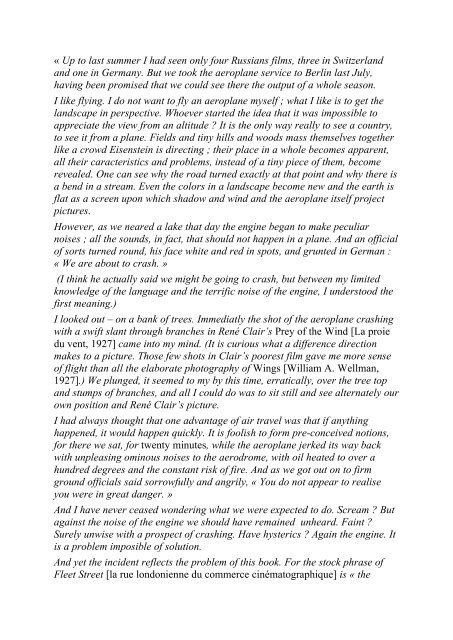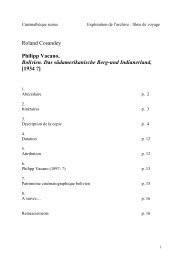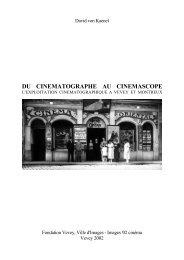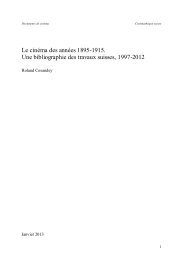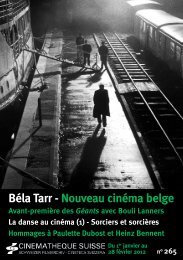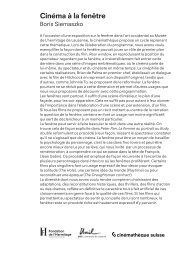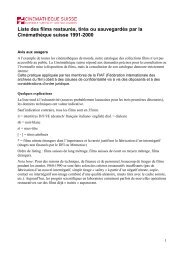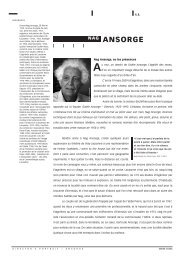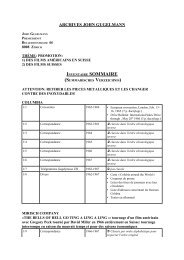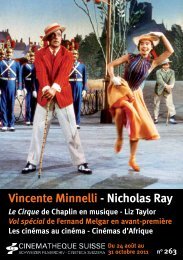Aviation et cinéma - Cinémathèque suisse
Aviation et cinéma - Cinémathèque suisse
Aviation et cinéma - Cinémathèque suisse
- No tags were found...
You also want an ePaper? Increase the reach of your titles
YUMPU automatically turns print PDFs into web optimized ePapers that Google loves.
« Up to last summer I had seen only four Russians films, three in Switzerlandand one in Germany. But we took the aeroplane service to Berlin last July,having been promised that we could see there the output of a whole season.I like flying. I do not want to fly an aeroplane myself ; what I like is to g<strong>et</strong> thelandscape in perspective. Whoever started the idea that it was impossible toappreciate the view from an altitude ? It is the only way really to see a country,to see it from a plane. Fields and tiny hills and woods mass themselves tog<strong>et</strong>herlike a crowd Eisenstein is directing ; their place in a whole becomes apparent,all their caracteristics and problems, instead of a tiny piece of them, becomerevealed. One can see why the road turned exactly at that point and why there isa bend in a stream. Even the colors in a landscape become new and the earth isflat as a screen upon which shadow and wind and the aeroplane itself projectpictures.However, as we neared a lake that day the engine began to make peculiarnoises ; all the sounds, in fact, that should not happen in a plane. And an officialof sorts turned round, his face white and red in spots, and grunted in German :« We are about to crash. »(I think he actually said we might be going to crash, but b<strong>et</strong>ween my limitedknowledge of the language and the terrific noise of the engine, I understood thefirst meaning.)I looked out – on a bank of trees. Immediatly the shot of the aeroplane crashingwith a swift slant through branches in René Clair’s Prey of the Wind [La proiedu vent, 1927] came into my mind. (It is curious what a difference directionmakes to a picture. Those few shots in Clair’s poorest film gave me more senseof flight than all the elaborate photography of Wings [William A. Wellman,1927].) We plunged, it seemed to my by this time, erratically, over the tree topand stumps of branches, and all I could do was to sit still and see alternately ourown position and René Clair’s picture.I had always thought that one advantage of air travel was that if anythinghappened, it would happen quickly. It is foolish to form pre-conceived notions,for there we sat, for twenty minutes, while the aeroplane jerked its way backwith unpleasing ominous noises to the aerodrome, with oil heated to over ahundred degrees and the constant risk of fire. And as we got out on to firmground officials said sorrowfully and angrily, « You do not appear to realiseyou were in great danger. »And I have never ceased wondering what we were expected to do. Scream ? Butagainst the noise of the engine we should have remained unheard. Faint ?Surely unwise with a prospect of crashing. Have hysterics ? Again the engine. Itis a problem imposible of solution.And y<strong>et</strong> the incident reflects the problem of this book. For the stock phrase ofFle<strong>et</strong> Stre<strong>et</strong> [la rue londonienne du commerce cinématographique] is « the


